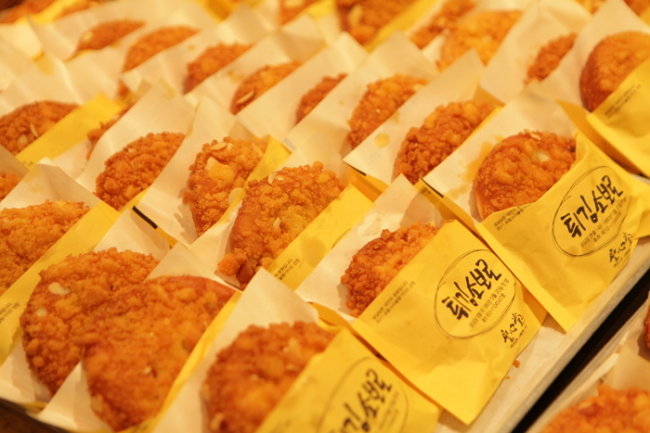Despite the vast demand for additional chains in other, more populated areas like Seoul and even abroad, Sungsimdang stubbornly refuses to expand beyond its three local stores, which have now become Daejeon landmarks.
“We want to be unique to the Daejeon area and provide a flavor that people can only taste when visiting here,” said Kim Kang-eun, head of public relations at Sungsimdang.
That flavor is the reason foodies and tourists from all over the nation have flocked to the Eunhaeng-dong area for nearly 60 years.
“We want to be unique to the Daejeon area and provide a flavor that people can only taste when visiting here,” said Kim Kang-eun, head of public relations at Sungsimdang.
That flavor is the reason foodies and tourists from all over the nation have flocked to the Eunhaeng-dong area for nearly 60 years.

The bakery’s signature item is the “twigim soboro,” or fried streusel bread, which boasts a sweet, red bean paste filling encased in a crispy, cookie-crumble bun. While red bean buns have been a popular snack in Korea since the early 1900s, Sungsimdang came up with the idea to fry them in oil in May 1980.
“That was a time when not many types of bread existed in Korea,” said Kim. “Sungsimdang was among the first bakeries to devise creative new items that could appeal to the Korean palate.”
“It’s deliciously warm, soft and crunchy all at once,” said bread enthusiast Julie Lee, 25, who frequents the stores during her travels. “Though a bit oily due to the frying, it’s definitely richer than your average red bean bun.”
Another much-craved item is the “pantalon boochu” bread, featuring an unusual combination of chopped Korean chives, eggs and tofu inside a pillowy bun, which makes for an unexpected harmony and a nutritious mouthful, said Lee. Created in 1986 and inspired by old-school Korean snacks, the menu has become a favorite among both the elderly and the young.
“It’s lighter than the soboro, and surprisingly tasty.” Lee said.
Sungsimdang ― whose name means “sacred heart” in Korean ― was founded by Lim Gil-soon in 1956, a time when many were starving from post-Korean War poverty, with the aim of nourishing and rebuilding the Daejeon community.
By Rumy Doo (bigbird@heraldcorp.com)
-
Articles by Korea Herald









![[Kim Seong-kon] Democracy and the future of South Korea](http://res.heraldm.com/phpwas/restmb_idxmake.php?idx=644&simg=/content/image/2024/04/16/20240416050802_0.jpg&u=)








![[KH Explains] Hyundai's full hybrid edge to pay off amid slow transition to pure EVs](http://res.heraldm.com/phpwas/restmb_idxmake.php?idx=652&simg=/content/image/2024/04/18/20240418050645_0.jpg&u=20240418181020)

![[Today’s K-pop] Zico drops snippet of collaboration with Jennie](http://res.heraldm.com/phpwas/restmb_idxmake.php?idx=642&simg=/content/image/2024/04/18/20240418050702_0.jpg&u=)